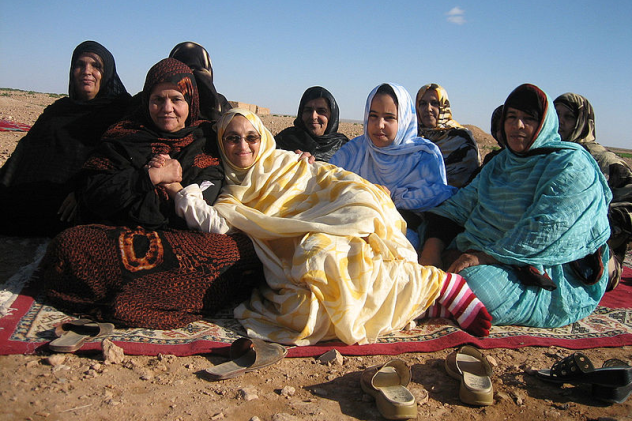10 The ‘Marinated’ Zanzibari Bride
During the days leading up to her wedding, a Zanzibari bride is pampered in ways that would befit a fairy princess. First, a special hut is prepared for her. She will spend about a month in seclusion in this hut, away from the prying eyes of any males. Qualified women usually stay with her in the hut, giving her advice and lessons on how to take care of her new husband and home. They make sure that she knows how to keep her home clean, cook for her husband, entertain him, and even how to behave with her in-laws. Two weeks before the wedding, the qualified women prepare the bride’s body so that on the big day, everyone is fascinated by her beauty, especially her husband. She is given a daily body scrub, known locally as a singo. This is a natural scrub made from a concoction of spicy herbs and delicate flowers. The main flowers used are usually sweet-smelling jasmine, fragrant rose water, and Cananga odorata (commonly called ylang-ylang), a yellow flower used all over the the world to make perfume. The main spices used include the local sweet-smelling mpatchori (a violet-flowered, scented geranium), Tanzanian sandalwood, and green, sweet basil leaves. The flowers and spices are ground up in a large, wooden mortar with lots rose water to form a smooth paste. Sometimes, if the girl is from an affluent family, honey and milk are added. The concoction is then rubbed onto her whole body, except for her hair. It marinates and exfoliates her skin, giving it a fragrant, silken, glowing allure. This makes her irresistible to her husband on the wedding night. She is then given relaxing massages with coconut oil and doused with perfumed rose water. The hut is continually filled with incense smoke to perfume her body and hair. Two days before the wedding, henna is used to draw intricate designs on her hands, legs, and sometimes her back. Finally, on the wedding day, she is dressed with colorful khangas or lessos, and she is ready to be presented to her husband. The ceremony normally takes place in the afternoon or at night and is mostly attended by women. Perhaps the bride would be too great of a temptation for the men.
9 Love Huts
In the Cambodian village of Ratanakiri, a woman’s preparation for her marriage involves empowering her mentally. A girl is given a sense of control over her choices. It is for this reason that in the Kreung hill tribes in Tang Kamal, the fathers of teen girls as young as 13 years old go out of their way to build special “girls’ houses,” as they are referred to in the local community, although they are subtly nicknamed “love huts.” The young girl normally sleeps in the hut alone. She is also encouraged to use this little abode to entertain different boys. She decorates the hut with flowers and mats on the floor to make it comfortable for her guests, who usually come under the cover of darkness. Normally, a girl engages in conversations with her visitors, but she can also have sex with them if they have a deeper friendship. The choice is hers whether a boy can come into her hut or not, as is whether or not she will have sex with him. This gives her a sense of being in control because the boy cannot contend with her choice. Boys can take gifts to the girl in the hope of winning her favor. She will eventually decide which of the boys will marry her when she feels that she is ready for marriage. Premarital sex is valued among the hill tribes, and it is believed that by engaging in it with different boys, girls become mentally empowered. But times are changing, and some families are ditching this age-old custom of preparing their daughters for marriage. Nowadays, families are building larger houses, and the young girls are given separate rooms inside the house. The girls still engage in premarital sex, although the parents also play a part in deciding whom she does it with. The custom has had its fair share of trouble, though, as unplanned pregnancies can result (despite the use of condoms), and young boys will fight over the girls.
8 The Veil
Covering the bride before she is presented to her new husband is common. Veils are a common choice for many brides, mostly to cover their faces. They can be made from netted polyester or some other delicate material. Some groups take the idea of veiling the bride further. When an Anlo Ewe bride is finally handed over to her new husband after a period of seclusion, her parents cover her body with powder as a symbol of her allegiance to her new husband. Among the Shona people of Zimbabwe, after the bride finally decides to go to her husband’s house (which she doesn’t have to do immediately after the wedding), she is draped in white so no one will see her. The traditional Japanese bride’s body is painted white to signify to all that she is a maiden. Her traditional kimono dress is also white, as is her intricate headpiece.
7 The Virginity Test
Virginity is viewed by many as a sign of purity. In many cultures across Africa, the Arabian Peninsula, and in the Far East, a woman who gets married while she is still a virgin brings much pride and wealth to her father, although it is the mother’s responsibility to ensure that her daughter does not engage in sexual experiments before marriage. Doing so would tarnish the family’s name. A virgin wife is also valued more by her husband in some places. In these cultures, such a woman attracts a higher dowry, which usually includes gold, money, camels, cows, goats, fine fabrics, expensive perfumes, spices, and even furniture. A girl discovered to not be a virgin on her wedding night will bring a lot of shame and dishonor to her parents and close family. Due to this, much care is taken to ensure that girls maintain their virginity. Abstaining from premarital sex was also a part of traditional American customs. Adolescent lovers were allowed some private talk, but so parents didn’t have to worry about them engaging in intercourse, they were tied up separately with cloth or blankets in a way that prevented them from being intimate. This was mostly practiced in colonial America but was also practiced in Northwestern Europe. Sometimes, a wooden partition was used In Islamic communities, maintaining a girl’s virginity is a deeply rooted custom. Girls and boys are segregated from an early age. Unmarried girls live under the watchful eyes of their parents and older siblings. Courting is discouraged, and traditionally, the parents choose spouses for their children. Although nowadays, young people normally do communicate before marriage, proof of the girl’s virginity on her wedding night is still highly valued. Normally, a woman from the girl’s family is assigned to take the sheet that the newlyweds use on their wedding night and display it to the family of both the girl and the boy. If the girl was a virgin, it is expected that the bedsheet will be stained with blood, due to the girl’s hymen having been broken. This custom is also practiced among the Swahili in the famous coastal towns of Mombasa, Malindi, and Lamu in Kenya. If the girl is found to be a virgin, the groom’s family commences elaborate celebrations that last two days, in which the bloodstained sheet is paraded in the streets for all to bear witness to the fact that their son made a good choice. However, if the bride is found to be “polluted” and doesn’t produce the expected bleeding to stain the sheet, it brings shame to her family, and the marriage could even be broken and the bride sent back to her parents’ home.
6 Zambian Sex Lessons
Sex is the foundation of many marriages, as it ensures the continuity of generations. The first sign that a marriage is going downhill is usually a lack or cessation of sexual intercourse between the couple. It’s no wonder, then, that many forms of advice exist today on how to achieve optimum performance in this very important activity. While some people feel hesitant to talk about sex with their children and leave the kids to their own devices as they grow up, others teach their children the ups and downs of sex. In some African countries, a woman can’t get married without sex lessons. In eastern Zambia, there is a well-known custom called chinamwali, which is an initiation practice for young girls aged around 11 and 12 years. It’s aimed at teaching the young girls every detail they need to know when entering into puberty. By the end of the three-month course, a girl is expected to be qualified in handling any man sexually. The main thing taught in chinamwali is sex, although other things like cooking skills and cleaning are taught. Graduates of these lessons are sworn to secrecy about the details of the age-old custom, but some have spilled the beans. Girls are taught on how to move their bodies in different sexual positions. They are made to practice some moves which can only be described as acrobatic, above planks of wood with protruding nails to discourage them from feigning fatigue. They learn to apply traditional herbs to make sex more pleasurable for the husband. They are also taught how to elongate their labia by pulling until they reach the desired length. It is believed that this process should be done while the girl is young and her body is still developing. Women who come from other Zambian regions that do not practice chinamwali have tried to “enhance” their labia after their husbands threatened to divorce them for chinamwali graduates. However, they have painfully learned that past a certain age, it backfires terribly, resulting in swollen and sometimes damaged labia. In the past, after the lessons, a girl had to go through a “tester,” who was preferably an old man and thus more experienced. His role was primarily to check that the girl understood all the important aspects of chinamwali, which mainly involved having sex her. If the girl was found to be lacking, she was sent back to “school.” Although the custom is still actively practiced in this region, the tester has been ditched. While chinamwali is aimed at preparing the girls for marriage, naive graduates will fall prey to men who want a taste of their sex skills, which have gained popularity across borders. Other chinamwali graduates have utilized their special skills and turned to prostitution, even advertising themselves as graduates.
5 Round Rotis
Those who have been to India and neighboring countries have definitely encountered roti. This is a thin flatbread similar to tortillas, made from wheat flour, water, and vegetable oil or fat. Rotis are commonly eaten for breakfast with curry and tea. You’re probably wondering what roti has to do with women and marriage. Well, have you ever heard the famous saying, “The way to a man’s heart is through his stomach?” In India, it’s not enough for a woman with marriage on her mind to be a regular cook; she must be a master of the roti. Not just any roti will do, though. It has to be perfectly round. Because rotis aren’t cut out with circular discs like donuts, making a simple roti could make or break a marriage in India. It’s common for a woman to be divorced just because she served an imperfect roti to her husband. Mothers have to tirelessly teach their daughters how to make perfect rotis before they can become suitable for marriage.
4 Female Circumcision
It’s common for men and boys to be circumcised, but when the same is done to women and girls, it raises more than just eyebrows. The practice is fairly common in the northern region of Sudan. It’s performed mainly in the Shendi and Haj-Yousif tribes. They believe that female circumcision promotes premarital chastity, and uncircumcised women are perceived as impure and thus not fit for marriage. Female circumcision is performed early in life while the girls are between the ages of four and nine. Some who practice it believe that it will prevent a girl from having wild sexual desires before and even after marriage. Others believe that a circumcised woman is cleaner. Still others do it because it is a societal custom. The process entails partially or totally altering the external parts of the female genitalia. Previously, female circumcision was publicly practiced and was accompanied by feast, song, and dance. However, it’s now done in secret because it’s illegal in many countries. This custom is also alive among the Somali, Masai, Kisii, and Meru tribes in Kenya, in Southeast Asia, in some parts of the middle east, and also in North African countries. Although men in these communities have first wives who are circumcised, they secretly choose a second or even third uncircumcised wife later on. Some women are open to this custom, which has continually attracted backlash from international activists, but those who would rather reject the practice often find that they have no choice against this tradition and its powerful influence.
3 The More, The Merrier
In Mauritania, a man’s love for his wife matches her size. When a man is looking for a wife in this region, he looks for a woman who will fill his house. It goes without saying, then, that a mother will do the best she can to “grow” her daughters to the appropriate size in a custom known as leblouh. During the precolonial period, most Mauritanians were nomads and lived in tents in the desert. Richer families could afford to own numerous slaves to do the daily chores. The women in such households were left with little to do, so they spent their days eating and relaxing in the tents. Consequently, they became more plump compared to their counterparts from poorer households. A man, therefore, took pride in a well-rounded wife because it was a sign that he was able to provide her with enough slaves and food. This is how leblouh came about. Leblouh is still very popular in rural areas, where girls are encouraged to consume extraordinarily gigantic quantities of high-fat foods. These include camel milk, goat milk, and millet coupled with plenty of water. This diet is regularly fed to the girls, mostly between the ages of eight and 14, so that by the time they reach appropriate marriage age, they will have gained as much weight as possible in the hopes of attracting a suitable marriage partner. Of course, children tend to be very picky about their food. So in recent times, some women have taken it upon themselves to preserve this custom at a fee. Mothers send their children to these women, who are famous for successfully compelling them to gobble up uncomfortable quantities of food and even use force if need be. Leblouh was introduced to the region by the Almoravid dynasty in the 11th century, and it spread to most of the areas that they conquered. It’s commonly practiced in parts of Mali, Cameroon, Niger, and Nigeria. Although a voluptuous woman is a symbol of wealth and affluence in these parts, leblouh is losing popularity among women today, owing to the many health complications it causes. Men still go for bigger wives, though.
2 Divorced Sahrawi
Marriage, to say the least, is not for the faint of heart. It takes a lot of patience and perseverance to be successful. But sometimes, a marriage fails despite all the effort put to it, and couples eventually decide that the best option for them is divorce. While most of us view divorce as depressing and heartbreaking, in the western part of the vast Sahara desert, there exists a tribe called the Sahrawi. In this community, three months after a woman is divorced, her female relatives throw a party for her. The celebration is marked by feasting, song, and dance. This fanfare lets the men know that the woman is now available to remarry. In most cases, a new suitor presents himself at the occasion. In this community, a woman with marital experience is more valued, so divorcees don’t stay single for long.
1 The Independent Mosuo Woman
Women generally go to great lengths to prepare for married life, and their efforts are usually aimed at pleasing other people. On the other side of the coin, there is a tribe in China where women don’t get married at all. The Mosuo people, who live in the Himalayas, are nicknamed the “kingdom of women.” Marriage doesn’t exist, so the women are taught to be independent from men. A Mosuo household is directed by its eldest woman, while everybody else works to provide day-to-day necessities. Since living quarters are communal, when a girl comes of age, she can have private sleeping quarters in her family’s house. In these quarters, she can have sexual relations with any man she chooses. She can have one or many sexual partners, and these relationships can be long-term or short-lived but never permanent. However, most women choose long-term pairings, changing sexual partners infrequently. Men must come to a woman’s quarters secretly at night and must leave before sunrise. Even if she becomes pregnant, the man responsible isn’t expected to have any part in the upbringing of the child. If he chooses to provide for the child, he can only do so by bringing gifts to the woman’s family. Children are raised communally by the woman’s relatives. The region where the Mosuo live has turned into a tourist hub largely because of the intrigue that comes with this tribe, and the Mosuo women have taken full advantage of the situation. Some of them manage successful tourist hotels, and others work as tour guides. Joy Susan is a professional jewelry designer with interests in cultures and geography.























